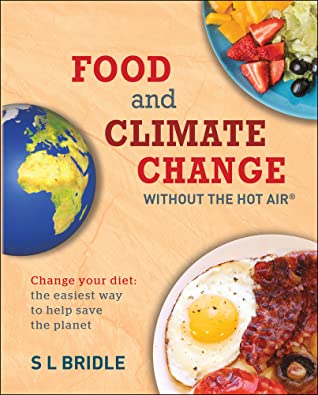Food and Climate Change without the hot air
Bridle shows the emissions from various components of the meals she discusses. The book gives options for things we might eat and drink for breakfast, lunch, snacks and evening meal. She highlights foods that have the greatest climate impacts and suggests how meals can be tweaked to reduce emissions

Published by UIT Cambridge, 2020
This book is modelled on David MacKay’s Sustainable Energy without the hot air, first published in 2008. That book had a resolute focus on the numbers in energy debates: how much energy various things use and how much could be produced by the different forms of renewable generation. I read it a few years ago and remember learning that electric vehicles use a lot less energy per mile than internal combustion engine ones whereas hydrogen cars are probably not the answer because of they use a lot more energy. Bridle tries to do the same sort of thing with food, illustrating the text with ‘stacks’ showing the greenhouse gas emissions from the various components of the meals she discusses just as Mackay used bar charts to illustrate the energy used by alternative options. The book takes us through a day and gives different options for things we might perhaps eat and drink for breakfast, lunch and evening meal, plus snacks in between. This highlights the things that have the greatest climate change impacts (which are air freight, animal products and to a lesser extent rice) and she suggests how meals can be tweaked to reduce the emissions associated with them. Usefully she also compares these emissions with those from other activities: the production of an 8oz beef steak, the highest emission meal she discusses, causes, she says, about 10 kg of greenhouse-gas emissions, which is equivalent to driving a fossil-fuelled car about 40 miles; and one transatlantic flight a year is equivalent to eating one large steak a day (p.112).
Unfortunately though, I think that food is much too complex an area to be treated in the same, strictly quantitative way as energy. The problem with ascribing emissions to particular foods is that agricultural systems should be diverse, producing multiple products (see my review of Dirt to Soil). It is the emissions of the whole system, including those of external inputs (such as fertilisers, pesticides and bought in animal feed) that should be measured: we should aim for the lowest emission system then eat the outputs of that, rather than trying to measure emissions of individual foods. I acknowledge that this will not be as much help when deciding what to buy at the supermarket as the approach used in this book, but perhaps it is the way food retailers, wholesalers and those who procure food for institutions should go. They could develop relationships with low-emission producers, ensuring that all their products find a market and are use in the food supply.
The other difference from energy is that agriculture’s impact on the biodiversity crisis is hugely more important than that of energy, so I think it is wrong to simply consider the greenhouse gas emissions of food. Health does get a mention in this book, but not biodiversity, pesticides or, animal welfare considerations. These can result in different decisions when it comes to what food to eat. For example, beef may seem to be the worst meat from a greenhouse gas emissions perspective, but in the UK context, grazing by the right sort of beef cattle can be an important part of the management of land for wildlife; they trample bracken, which in upland areas otherwise takes over, and break up the sward allowing new species into the mix (see my review of Wilding, on the importance of the right sort of herbivores). From a welfare point of view they are also treated pretty well. In contrast, most UK broiler chickens (presented in this book as being the meat with the lowest greenhouse gas emissions) are kept indoors in huge flocks. They are bred to grow very quickly, constraining their ability to carry out natural behaviour. Outbreaks of COVID 19 amongst workers at slaughterhouses have resulted in chickens having to be gassed and disposed of because if the birds are left to grow beyond their slaughter weight they can become lame and unable to walk, or die of heart disease. Also, most feed for chickens is imported, much of it being soya meal from South Africa, where the growing of soya is a big driver of rainforest destruction, whereas cattle and sheep can be raised on grass, which the UK has plenty of.
Related to the lack of consideration of biodiversity impacts is Brindle’s scant treatment of organic food. This is discussed in just one box on p.119, which concludes that there isn’t a big difference in greenhouse gas emissions between organic and non-organic foods. I am not convinced by this. For example, she suggests that the energy needed to made synthetic fertilizers for non-organic farming is balanced out by the greater amount of nitrous oxide released from manure used to fertilize soil in organic systems. But there are doubtless ways the latter could be reduced while energy will always be needed to manufacture synthetic fertilisers. Fundamentally, organic systems should lead to soils with a greater organic matter, and thus carbon content, rather than the chemical-dependent ‘dirt’ that too many agricultural soils have become. Brindle does say that the tight restrictions on the use of chemicals in organic agriculture can increase the amount of wildlife on a farm and, in my view this alone means that we should eat organic food and promote organic agriculture as much as possible (plus I would rather avoid consuming pesticides myself). We are not going to survive the coming years of a changing climate without allowing nature some respite from the onslaught of all the chemicals we have poured onto agricultural land over the past few decades.
Food and Climate Change without the hot air is available as a free e-book, as well as a print version. Plus there are some ‘Climate Food Flashcards’, produced in conjunction with the book that can be used like top trumps or for other games.



